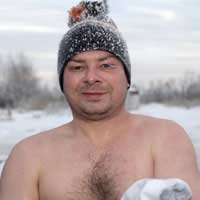Ice Swimming Safety

To the uninitiated the suggestion of swimming in a frozen lake may well invoke horror and bemusement, but to its champions in the globe’s frostier climes, it is a great safe route to good heath.
Land of a Thousand Lakes
Although a popular pastime across Scandinavia and in parts of Russia, ice swimming is most closely associated with the vast largely unspoilt wilderness of Finland. In these icy Nordic climes, the sport is known as ‘Avantouinto’, literally ‘ice hole swimming.’Hardy Finnish ice swimmers either take their short invigorating dip in one of Finland’s 170 plus official ice holes or they simply find a lake and cut out their own – and in a land with close to two hundred thousand lakes there are ample opportunities for D.I.Y. dipping.
But why? Living in a sub arctic country surrounded by lakes does not make swimming in iced water anymore a sensible way for humans to behave.
Health Benefits
Ice swimming improves body circulation and mood, builds up resistance to cold related illnesses and relieves symptoms of arthritis, or so its diehard fans claim (ice swimming only seems to attract diehard fans, indifference is not a common reaction). And there must be some weight to these claims because over 120,000 Finns pay regular visits to their local ice hole.The key to these health benefits is regularity. A one-off delirious few seconds in the water is not enough. If ice swimming is to work its peculiar magic then a visit to an ice hole must become part of the weekly routine.
The Risks of Ice Swimming
Needless to say ice swimming is not for everyone, but there are those who are advised not to take the plunge however keen. People with heart conditions, or any other serious ailment, may be susceptible to the effects of the freezing water and the accompanying shock, and should first talk over their plans with their GP before descending into the icy depths.Ice swimming can also present dangers to the most able-bodied and confident participants. For instance swimmers should take particular care around the edges of the ice hole. Getting lost under the ice is an ever present concern and potentially very dangerous.
Safe Temperatures
Managing a safe body temperature, is also another important aspect to consider when swimming.Although the immediate thought when climbing out of the ice hole might be to find somewhere warm to revive ones frosted blue body, sudden drastic changes in temperature are not healthy. The body needs time to acclimatise to its surroundings.
This is a particularly important consideration at the public ice holes with neighbouring saunas. It is tempting to heat up first in the sauna, and then descend into the icy waters before finally returning back to the comforting glow of the sweat box. This dramatic heat change of around 80 to 100 degrees can cause the body some distress. The heat causes the blood to rise to the surface of the body whilst the cold forces the blood back inside towards the heart.
Many swimmers don’t need the reassurance of an onsite sauna, and are happy with heated changing rooms. The hardiest scorn any kind of comforts and simply just strip off and leap in.
Safe Ice Swimming
First timers are advised to visit an official ice hole rather than cut out their own. This means they don’t need to worry about the maintenance and safety features of the site itself and can focus on the icy plunge itself. A standard public ice hole will usually provide a sturdy ladder into the water to aid safe entry and exit, and a heated carpet leading from the changing rooms to the hole.Ice Swimming or Winter Swimming in the UK
The UK climate is generally not cold enough for ice swimming but popular here is "winter swimming".There are organised winter swimming clubs and winter sea bathing is enjoyed around the UK coastline with minimum water temperatures between 6 - 10C depending on location. Inland waters are generally a little colder at between 2 - 6C.
Safe winter swimming does require cold acclimatisation training in order to be able to withstand immersion in extremely cold water without suffering cold shock. It is also essential to keep one's head warm and dry which is why "head-up breast" is the recommended stroke. Depending on individual physiology some winter swimmers may need to wear wetsuit boots and gloves to protect their extremities.
Business Energy With a Difference
If you are looking for business energy or need advanced solutions like remote energy monitoring, new supplies, downgrading or upgrading capacity, have a no obligation chat with Purely Energy.
To find our more get in touch here. or call 0161 521 3400.








